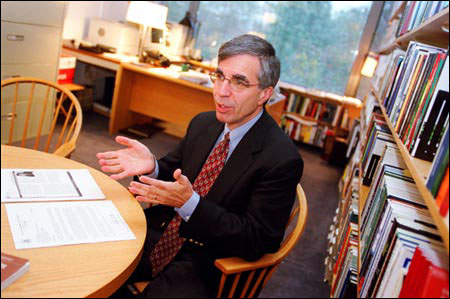Stavins steps down but not out:
Outgoing EPA economics head will retain seat on committee

Professor Robert Stavins stepped down last month after five years at the helm of the U.S. Environmental Protection Agency’s (EPA) top economic advisory board, during which time he helped to raise the profile of economic thinking about environmental problems and to standardize economic analysis in EPA decisions.
Stavins, Albert Pratt Professor of Business and Government at the John F. Kennedy School of Government and director of the University-wide Environmental Economics Program at Harvard University, retains a seat on the committee, but has handed off the chairman’s job to fellow committee member Maureen Cropper.
Under Stavins’ leadership, the committee was re-energized and achieved various goals, the most important of which was a revision of the EPA’s Guidelines for Preparing Economic Analyses. The guidelines provide standardized, updated procedures so that economic analyses for various projects are comparable across the agency.
“We never had a document in place that was raised to the level of the guidelines. By doing this we really elevate economics as a science across the agency,” said Al McGartland, director of the National Center for Environmental Economics at the EPA.
Just after he left the committee’s chairmanship, Stavins received a letter from EPA Administrator Christie Whitman, saying that funding had been restored in the agency budget for the Pollution Abatement Cost and Expenditure Survey. Stavins had fought for continuation of the survey as chairman because he felt the flow of data on pollution abatement efforts was important to maintain. That data, he said, would help guide future pollution abatement policy decisions.
Economics was once considered an unusual tool to inform environmentalist strategies, but people like Stavins have made it a more and more powerful part of environmental decision making.
Stavins started thinking about environmental problems from an economic standpoint during a stint as a U.S. Peace Corps agriculture worker in Sierra Leone. Having grown up in Chicago, the experience was the first to expose Stavins to the beauty of a relatively pristine environment. During the course of his work, he witnessed rapid development and the conflict between subsequent environmental problems and improvements in standard of living.
“I experienced the beauty and wonder of a pristine natural environment, but I also saw the extremely rapid pace of economic development leading to both environmental degradation and to better food and health care,” Stavins said.
Over the years, he’s come to believe that many of the world’s environmental problems are, at their root, economic and lead back to the need of humans to make a living: the need to buy and sell to raise money, the need to acquire land for subsistence agriculture, the need to feed, clothe, and house their families.
Global warming, for example, is driven by the fact that fossil fuels provide the cheapest and most convenient energy sources on the planet. The rapid increase in species extinction is largely due to the human need to make a living by logging forests, building in fields and marshes, or hunting wildlife.
“The cause of environmental problems is an imperfect market. Environmental degradation is an unintended product of economic behavior,” Stavins said. “If the market is the cause of environmental problems, certainly you want to look to the cause when designing the solution.”
While Stavins said economic analysis is essential when looking at environmental problems, he said it’s certainly not enough. Scientific, ethical, and even religious considerations, when appropriate, must also be brought to bear.
Times have changed radically for the field of environmental economics. It wasn’t long ago, Stavins said, that those in the environmental field were hostile to economic thinking. Stavins remembers teaching his first class in 1988. It had 25 students, not all of whom looked at him kindly.
“I walked into the room and there was suspicion in the air,” Stavins said. “Now it’s completely accepted. Things have changed tremendously in that regard.”
Things have changed so tremendously, Stavins said, that the same class this year attracted 120 students and enrollment had to be cut off because the room couldn’t hold any more.
That change in student thinking has been reflected in the world outside. The Environmental Economics Advisory Committee, coupled with the staff economists at the EPA, help keep the economic impact of proposed policies and regulations in the picture. Having that economic information at hand adds extra weight to the environmental argument when talking with lawmakers and administration budget officials, Stavins said.




